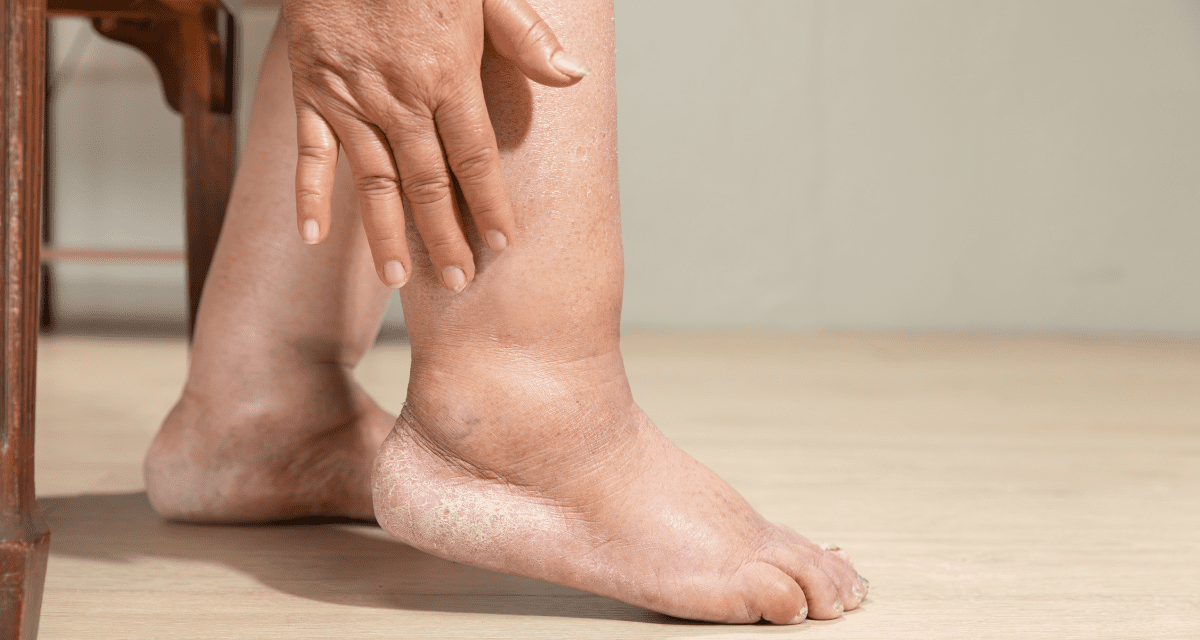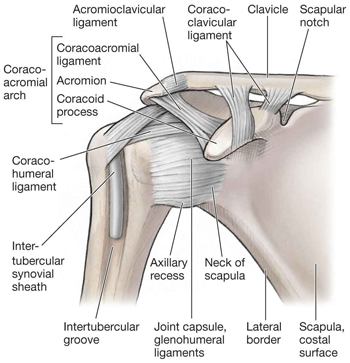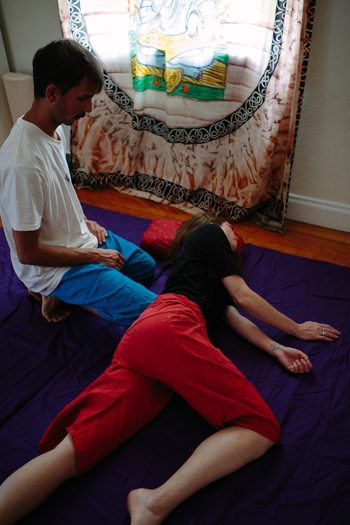The scapula is a large triangular-shaped bone that lies in the upper back. It is also known as the shoulder blade. How the scapula is connected to the rest of the skeleton? The scapula, compared to other body bonds, is connected to the main skeleton, a series of ligaments that sit only on one side and extremity of it. The ligaments are: transverse scapular ligament; coracoacromial ligament; coracoclavicular ligament; coracohumeral ligament; glenohumeral ligaments; acromioclavicular ligament. That’s for is also called a “floating” bond. So to be more specific, as any ligaments do not connect the medial or inferior/lateral borders to any other bond structure, the scapula is subjective to the muscle’s force. Indeed, the shoulder blades of an individual often don’t look the same. What do I mean by that? Well, starting from the fact that one body side is more dominant than the other. Take, for example, an office worker. Despite being seated or at a standing desk, most of the time, the dominant hand will be the one using the mouse, right? Where the non-dominant hand will be the one mainly sitting on the keyboard. Now, the hand that moves the mouse is less lucky to leave its position and do other tasks. As the mouse is in constant action, that hand is in continuous movement, yes, but it doesn’t go that far. Indeed, the non-dominant hand would move more freely as it is not always typing. Said so, the arm controls that hand per consequence, moving less. Due to the poor ergonomics of many desks, that arm is seated on a narrow-angle, so the elbow is constantly flexed. All this micro action, multiplied for days, weeks, months and years, brings the scapula to the mercy of the muscle force. As per this example, the bicep force. We did mention just now that the elbow is constantly flexed, right? So the Bicep, the primary elbow flexor, will be constantly under tension. Now, looking at the bicep origin, we find that: The short head originates in the Apex of the Coracoid process of the scapula The long head originates in the Supraglenoid tubercle of the scapula This is then how the scapula gets constantly pulled from this muscle. Then obviously, there are other muscles to play a contro-part. In this case, we can think of the lower trap and the lat dorsi, which inserts at the inferior angle of the shoulder blade, so on the opposite side of where the bicep pulls from. But if those muscles are not trained to compensate for the constant pulling force of the flexed arm, then the scapula will be tipped out. What is a tipped Scapula? For “tipped scapula, ” we refer to a scapula with a prominent inferior corner. On the other hand, especially for the coracoid process, there is more muscle originating from that area, such as the Pectoralis Minor and the Coracoid Muscle. Now, after analysing how muscle tension can move the scapula around, we can talk about other scapula facts. So a Scapula should sit with the inferior angle at the high of T7 (vertebrae). But that’s not always the case. So we can have a “depressed” scapula that can sit lower than T7 or an “elevated” scapula that can sit above T7. Lev scapulae and lower trap are the muscles responsible for a depressed or elevated scapula. It all depends on the tightness or laxity of the muscles. Furthermore, we can have a “winged” scapula. Therefore, the medial border is visibly protracted. For this case, is Serratus Anterior responsible for the winged shoulder blade. As this muscle gets loose, the shoulder blade escapes the rib cage. On the other hand, when we look at a scapula, we also see if it is “downwardly rotated” or “upwardly rotated”. Preferably we would like to see the shoulder blade being upwardly rotated. That means having the superior angle closer to the spine and the inferior angle further away. Why so is because when we elevate the arm, either in flexion or in adduction (flexion on sidewise), the scapula is ready to follow the humerus. In this post, I already talked about the muscles involved in the scapula rotation. How can massage help with shoulder pain? We always have to look at the presentation regarding massage and treatment from which a shoulder can benefit. A Myotherapy, Remedial Massage or a Thai Massage is good to: improve mobility; reduce tensions; alleviate trigger points; rehabilitating the shoulder. MLD, on the other hand, is more recommended for fracture; inflammation of the muscle surrounding the shoulder; pre-post operation; swelling; skin rash on the shoulder area. In conclusion, if your shoulder needs some work done, your next massage is a click away.
Monthly Archives: May 2022
Often when I introduce myself to people, as a massage therapist, and I mention that I work with Thai Massage, they look at me and say things like: “Oh I love Thai Massage, I love that knee in my back” or “Thai Massage? Not for me, it is too painful” Both those ways of talking are often a sign of a poor understanding of the importance of Thai Massage and are based on the commercial knowledge of this ancient technique. Unfortunately, Thai Massage has the reputation of the massage “go hard or go home”. But is that a real thing? I mean, is this what Thai Massage should be? Massage and pain are 2 things that are strictly correlated. Most of us go for a massage when we are in pain, isn’t it? During the massage, even during a Remedial or Myotherapy treatment, we are going to experience pain. And you know what? That’s normal. Actually, that’s what those techniques are based on too. That pain sensation that you experience during the Remedial or Myotherapy session as per the Thai session, is what makes the massage work. What is the purpose of pain during treatment then? Well, that pain is a response of your body to trigger point stimulation. What happens next is that, by stimulating a trigger point, the body will release an immune response that would facilitate the trigger point to dissipate. That’s why during a session as massage therapists we ask: “How does it feel?” “0 to 10? what’s the sensation feel like?” Book now your next Massage. So is pain normal during a massage? Yes, it is normal. But back to the start, in Thai Massage often the therapist due to their poor training are told to “go hard or go home”. It is a tourist thing. It is the westernization of an ancient healing technique. And unfortunately, it will now take years to change the mindset of people about it. Again, a knee on the back is a real thing, but it doesn’t have to hurt more than what a hand can do. So why use the knee on the back? Well, it is just more ergonomic for the therapist. It prevents the hand of the massage therapist to be worn out. But again, in order to use a knee on the back, leg, or shoulder, there is a need for some training, things that at the Thai Massage front shop, often, the person working there, doesn’t have.
When experiencing pain around the head, we talk about Headaches. Headache is a common condition, and for most cases, is not considered a serious illness. Migraine and headache. 4.9 million Australians experience migraine. Migraine is a specific type of headache, so consider that the number stated above is still a small figure. Headache and muscle. If you ever experience a headache, you may notice that the pain sensation does start from your cervical area. Or, by confronting yourself with who is around you, your headache pain pattern, is consistent, but it is different from the one of someone else. On the other hand, you may associate headaches to the result of a heavy drinking night, or of lack of water (which is why you get headaches after a heavy drinking night, by the way), but often headaches are there because of cervical muscle tightness. Wait, what? Yes, you did read right. How can we define then if the headaches come from muscle tension? So in order for this to happen, the muscle responsible for referring its pain up to the head must be tight or stretched out, and loaded with trigger points. As massage therapists, especially in the first consultation session, we would ask about headaches and if there are any, “where about do you feel the headache”? Indeed, the answer to this question is most luckily the giveaway to know which muscle is may responsible for your headaches. To confirm the suspicions, we would then assess your posture, looking for any muscular-skeletal unbalance, and then we would assess the Range of Motion (ROM). If the ROM show up to be limited on the muscle that we believe is responsible for the pain in the head, then most luckily we are halfway through the solution. I do say halfway through, a single massage session either Myotherapy, Remedial Massage, Thai Massage, or MLD is maybe not enough to release all the tension that is in needs to be alleviated to eradicate the headache. Said so, no journey starts, without doing the first step, isn’t it? When a headache is a Red Flag? For red flags, we refer to symptoms that may be present due to serious illness or condition. Some example includes clients who had a clinical history of stroke and or brain cancer, a recent car accident or recent head trauma, or blurred vision. If that’s the case, the next step is referring the client to a GP immediately for further investigation. What about the cervical muscle tension headaches type of presentation? As already mentioned in another blog post, the Occipital muscle can have headache type of pain in the lower section of the posterior side of the skull. If we then look into the area of the skull that seat above the ear, could be more tension from the Upper trap or Levator Scapulae. By keep moving more medially and above the head, Splenius cervis can refer to the medial superior side of the head and Splenius capitis to the middle top side of the head. Sternocleidomastoid, indeed, can refer to the frontal lobe of the skull. Now, all these muscles are sitting on the neck and throat and from above the shoulder. So, ensuring that those areas are free or not overloaded with tension can help in staying headache-free. Now, in this blog post, we are keeping the headache presentation type of pain to its simple aspects. On the other hand, the topic can be further discussed in person with Giovanni during your next massage appointment. Book now your next massage session, if you are trying to get to sort out your headache presentation. Other approaches to a headache-free life, out of massage therapy. There is a series of things that complimentary massage can help with to relieve headache pain. Exercises Keep yourself hydrated Good posture when seating and standing Good variety of food as diet intake Wearing glasses if needed. Meditation for stress management In conclusion, headache is a really common problem for all Australians, for both women and men. Don’t wait for your symptoms to get worse; you may not need to take medicine all the time if you have a headache, as the medicine will just numb the symptom but will not sort out the problem. If you are keen to learn more about where your headache may be coming from, book your next Massage Session today.
In the previous post, we did look into plantar fasciitis and we only mention the Corrective Exercises for Plantar Fasciitis. Indeed, we did get to the conclusion that Myotherapy, Remedial Massage and Thai massage can help in reducing muscle tensions, for those muscles which take part in the foot’s unbalance, and that MLD can help in reducing the pain and reducing the inflammation within the plantar itself. What’s the role of the Corrective Exercises for Plantar Fasciitis? Exercises are a crucial step to take for a successful healing process. Corrective exercises for plantar fasciitis can be simply practised at home, without the aid of a personal trainer to follow you. In fact, corrective exercises are often simple movements, that require precision more than strength. Furthermore, is better to start slowly and gradually implement more difficult exercises and extra load. Indeed, the corrective exercises world is a step-by-step journey. If this post is talking to you, book your next massage session by clicking here. Corrective Exercises for Plantar Fasciitis: Foam rolling below the foot. Take a seat on a chair and start gently rolling the affected feet along on the foam roller. The bigger the foam roller, the gentler the exercises, due to lower pressure. If you have no foam roller, you can use a tennis ball too. The aim of these exercises is to gently self-massage the plantar of the feet and stimulates blood circulation within it. Plantar pressure with a towel. Always in a seated position, roll a towel on itself, and by holding it with both hands, put the towel under the foot. Start pulling the towel against the plantar of the feet Pull and hold for 15 to 30 secs about Drag the towel with the toes. Place a towel on the floor. The backside of the towel will be right below your toes Now gently, start grabbing the towel with your toes These exercises will reinforce the flexors muscles of the toes, in specific Flexor hallucis longus and Flexor digitorum longus, with the aim to improve the arch below the foot Single Calf Raise For this exercise, you will need a small stool or an Aerobic Step Kit Step with the front of the feet on the Areboic Step and start pushing up through the foot. For safety, you may wanna hold yourself to a wall with your hands You can start doing 1 foot at a time to increase the load. These exercises would create strength in the plantar flexor muscle of your foot. Along with the same muscles that do plantarflexion, there are the ones that do eversion and toes flexion too. In specific Perenous Longus, Perenous Brevis (eversion) and Flexor hallucis longus and Flexor digitorum longus (Toes flexion) If you suffer from plantar fasciitis because of an excess load of the body weight on the external side of the foot, these exercises would help you in recreating balance in the body load on the foot. Said so, those are some of the exercises that can be done. Few more are out there. If specific to your condition, you may want to do some exercises more than others. Most important is to have someone diagnose you with the specification of the condition and then suggest to you what exercises are the best. Plantar Fasciitis is a chronic condition, that with the right exercise and determination can be fixed. If you need help with it, don’t hesitate to book now your next session with Melbourne Massage and Treatment. And what about Orthotic Insole? The orthotic insole can be a quick-release type of approach for foot pain. On the other hand, orthotic insoles are most luckily the more common and misunderstood tool for foot pain. Yes, good to quickly reduce severe symptoms, but by itself is not going to fix the problem. Indeed, before spending hundreds of dollars on Orthodics, give a fair trial to exercises.







